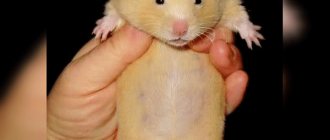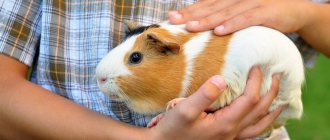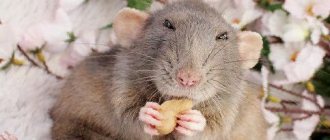Today the Internet occupies an important place in the life of every person. After all, most people turn to the World Wide Web . It's fast and practical. In Poland this is no exception; Poles actively use Internet resources for their needs. And now we’ll look at what are the most popular Polish sites.
All Polish sites can be divided into several categories.
Keep a male and a female in the same cage if you do not plan to have babies
Some inexperienced owners buy a pair at once - a female and a male, believing that they will have much more fun together.
However, one should not rush to conclusions. If you put a boy and a girl in the same cage, then one day they will make you happy with offspring. And it will not be one or a couple of small animals, but at least a dozen at once.
If you are not ready to breed these rodents, then it is better to purchase one. Hamsters themselves are not social animals; they do well without company, in splendid isolation. And so that they don’t get bored, you can place various wheels, labyrinths and hammocks. Nowadays you can find a wide selection of products in the pet store.
Job
- . Useful for those interested in career growth. If you need to find a job, you will need to register and submit your resume. There are also useful articles that will help you make a good resume.
- . Virtual Bank of Poland, one of the first. Popular among users, it has deservedly received trust.
There are several other popular sites for finding work in Poland, about which you can learn more in the article “Working in Poland.”
Using the wrong bedding
In order for a hamster to feel comfortable and please its owners with its healthy appearance and active games, it needs to choose the right food, change the water often and use the right litter for the cage.
You can find a lot of bad advice on numerous forums on the Internet. For example, that rodents love rags. Bury yourself in them and live there. However, this is not at all true. The rags will quickly absorb dirt and become unhygienic. Besides the fact that it will emit an unpleasant odor, and aromas are important for hamsters.
Other materials such as:
- softwood shavings;
- cat litter.
Good, quality bedding material is very important for your pet. At the pet store you can find:
- Hay. You can not only purchase it, but also prepare it yourself. The hamster will be able to make a nest out of it and even feast on it on occasion. However, its environmental friendliness is not always guaranteed.
- Sawdust. This is an inexpensive and universal litter that is suitable for any rodents. However, due to their very light weight, they will be not only inside the cage, but also outside it.
- Wood pellets. Or pressed sawdust. They absorb odor better than all of the above and are environmentally friendly. However, some types of hamsters will not be comfortable living on the pellets as they are quite large in size. In addition, they contain wood dust, which does not have the best effect on small animals.
- Cellulose filler. Externally, it also looks like granules, but not as large in size as wood. They are the safest and most convenient. But they don't absorb odor so well.
The following compounds are strictly not suitable:
- Newspaper. This filler was used quite widely in the past for lack of anything better. However, printing ink alone can cause irreparable harm to your pet's health.
- Plain paper. The hamster will definitely try it on his teeth and may be injured by the sharp edges.
- Cotton wool. Some people also use this kind of filler, motivated by the fact that it will be a cozy nest. Maybe the house will actually turn out to be quite good, but the fibers of this material can wrap around the paws and cause irreparable harm to the limbs.
The issue of bedding for a small rodent should be taken very seriously.
What types of hamsters are there? Photo and title
There are both species of hamsters that are quite familiar to us, as well as very rare and unusual ones. Each of them has its own distinctive features of appearance and habits. Here are the most common and interesting breeds of hamsters:
Djungarian hamster
Perhaps the most popular home species. They are small, but not quite tiny - the body length is approximately 10 cm. In the middle of the back, from the back of the head to the base of the tail, there is a pronounced dark stripe. At the top of the head it turns into a triangle, going down to the nose. The rest of the fur is smoky gray with small white areas. There are also specimens of other colors - with a bluish, pearl or red tint. Dzungariki require careful care. If you don’t tidy up the cage in time, a very unpleasant smell, reeking of ammonia, will spread throughout the apartment. Therefore, ideally, home cleaning should be done daily.
Taken from Wikipredia.com
Posted by Wilson Aniston
Field hamster (wild hamster, forest hamster)
People also call this animal “karbysh”. The peculiarity of this breed of hamster is that it almost never digs minks itself, but takes them away from other rodents like gophers. Having taken possession of the home, the karbysh adds to it a couple of extra entrances and exits and separate “rooms” for the toilet, sleeping and storing supplies. The result can be a real intricate labyrinth up to eight meters long.
The field hamster is quite aggressive towards anyone who potentially encroaches on its place of residence. It will literally fight to the death for its territory, and it doesn’t matter what size the enemy is - often the animals even attack large dogs or people. The animal's teeth are very sharp and grow throughout its life, grinding down as the field hamster gnaws on something. Before attacking, it often rises on its hind legs, snaps its teeth and makes threatening sounds.
The size of hamsters of this breed can vary from 5 to 37 cm, if you do not take into account the length of the tail, and weight - from 45 to 700 grams. They have rather large, round ears, and their paws are always white. Thick fur, combined with undercoat, allows the animal to survive the frosty winter. But, in addition to frost, the animal has many enemies among the animal world - from rooks to foxes. Farmers are also opposed to them, whose crops the animal can seriously damage.
From October to February, the field hamster hibernates, slowing down all metabolic processes. When it gets warm, he does not crawl out of the hole right away, but first eats up all the supplies left over from the fall. By that time, the mating period has just begun, during which this wild hamster is very active.
Author: Adams Moran
Common hamster
The most common representative of the species. Its average body length is 35 cm, and the body ends with a thick, strong tail 5 cm long. The ears are short and dark, the belly is also dark, but the upper part of the body is usually golden. The common hamster lives in the steppe and meadow zones of Europe, rarely rising above 1.5 km above sea level.
The animal's diet includes various parts of herbs and other plants. In the fall, mainly seeds and tubers are used, the same is suitable for stocks for the winter period. Amazingly, this little animal can speak up to 15 kg of food. The most common items collected in the “pantry” are peas, corn, selected cereal grains, potatoes, millet, and lupine. The pantries are always in order, even seeds of different varieties are stored separately from each other.
Author: Aiti Kiperman
Two or three times a year, mainly in late spring, the common hamster reproduces. Usually each litter brings from ten to twenty small animals. Three weeks after birth, they can already switch to adult plant food, as well as some animal food (insects). In October, the rodent goes into hibernation, but it does not sleep continuously; sometimes it can wake up and have a snack when it is warmer than -20C outside.
The common hamster is included in the list of animals protected by the Berne Convention, founded by the Council of Europe in 1976, and it is also listed in the Red Book of the Lipetsk Region. This species is often kept in a cage at home as pets. He can live well at home, but here some nuances should be taken into account. First of all, this is hibernation. Also, an ordinary hamster can significantly damage furniture and wires with its teeth, and in adulthood show inexplicable aggression. However, the animal quickly forgets the insults and becomes peaceful again. It can even be trained, and it reproduces well in captivity.
Author: Misha Fisenko
Angora hamster
This breed is mainly distributed in Central Asia and both American continents.
The hamster's coloring perfectly matches the animal's natural habitat. But the Angora hamster can have absolutely any colors. In the middle of the 19th century, these hamsters began to be bred in captivity; soon breeders managed to breed individuals with long fur, the shade of which ranged from silver to black. So today, anyone who wants to buy an Angora hamster will have a wide choice.
Many sources often confuse the concepts of “Angora hamster” and “Syrian”, claiming that they are one and the same thing. But in fact, the Angora is only a variety of the Syrian, which has only a sandy shade of fur.
Caring for an animal of this breed is not much different from caring for other hamsters; they also need a clean, comfortable cage, good food and water. But there are added concerns about keeping the fur in good condition, otherwise it will quickly become dirty, matted and look unsightly. However, you cannot bathe the animal, it is dangerous for it. Provide him with a sand bath where the Angora hamster can clean his fur on his own. But do not forget to comb the coat regularly to prevent matting.
Posted by: Matthew Kitler
As for food, it should be taken into account that Angoricas are bred at home, which means they are more picky about their diet than their wild relatives. Its basis is grain crops, which saturate the body with fiber, and its addition is nuts, vegetables and fruits, rich in plant protein. The Angora hamster can happily eat flax, millet, tomatoes, and pumpkin. Of the seasonal fruits, it is allowed to give him pears, apples, and grapes. Other products include fermented milk and boiled chicken. The main thing is not to overdo it with unusual nutrition and, of course, all products must be impeccably fresh.
Author: Ivan Odnekovsky
Campbell's hamster
This animal belongs to the dwarf hamsters; it was discovered in 1904 on the border between Russia and China. Externally, the Campbell's hamster can be similar to a dwarf hamster, which is why they are often confused. It has a pleasant amber or sandy fur color and a dark stripe along its back. There is no hair on the paws, and this species does not change its coat for winter. This type of hamster lives shorter than others - on average 2 years.
There are two main types of color that a Campbell's hamster can have. The first is agouti, where the top of the coat may look a little darker as it gets closer to the roots, and there are lines on the sides separating the back from the belly. The second is selfie, when there are no stripes on the back and sides, the color is almost uniform, with the exception of minor spots on the chest or belly. The hamster's fur grows unevenly, as if in clumps, because it is directed at an angle.
Author: Maria Shepova
The Campbell's hamster is so tiny that its weight barely reaches 50 grams and its height is up to 10 cm. Its character is quite complex, and care should be taken not to get bitten by sharp teeth. Due to its size, a small aquarium can be adapted for the life of a rodent. However, if you have a whole family of hamsters, then they need a lot of space - otherwise there will be constant fights. The cage or aquarium should be in a fully illuminated place, but a window sill is not suitable for this - there the animal will be tormented by drafts and direct sunlight, and there is usually a hot radiator under the window.
Campbell's hamster breeds over a period of six months, from March to September. Pregnancy lasts for 2-3 weeks, after which the female can give birth to 3-4 cubs. The babies will grow fur on the fifth day, and open their eyes on the tenth.
Author: Konstantin Abramov
Roborovsky's hamster
This is another dwarf breed that is sure to be loved by those who dream of a small pet. This species is native to Asian deserts, particularly Mongolia and China. In the Russian Federation, it can also be found in the wild in mountainous regions near the Asian borders.
This is one of the smallest hamsters in the world - its length from nose to tail tip rarely exceeds 5 centimeters, and its weight is 25 grams. Round ears are set high on the head, the eyes are slightly bulging. The species is distinguished by its snow-white brow ridges, reminiscent of a mask. The hamster can jump quite quickly due to the fact that the front legs are shorter than the back legs.
Like many desert hamsters, this breed has a sandy coat color, but many other colors have been developed through genetic mutations. But, it should be borne in mind that animals with unusual colors are much weaker in health. In general, these hamsters are very active, they are constantly on the move, literally never sitting still for a second. At the same time, they almost never bite, having a peaceful disposition. But it’s unlikely that Roborovsky’s hamster will allow himself to be calmly held in his arms and stroked while watching TV - this is not in his character. The animal may become frightened and become very stressed.
Despite their tiny size, this breed of hamster needs a spacious cage where they have plenty of room to run and climb. And the more “tenants” there are in the cage, the larger its size should be. It is best to use an aquarium made of glass or acrylic with a wall height of at least 20 cm for keeping the animal. However, the glass can fog up. So you can consider another option made of plastic. A cage with bars is unlikely to be suitable - the nimble rodent can get through even very small holes.
Posted by Kasandra Nikson
Author: Eduard Agapov
Sungur hamster
It differs from its relatives in that it stays awake a lot during the day, giving the opportunity to fully communicate with it. It comes from desert and steppe areas of Asia and Western Siberia. In the wild, this hamster can cover vast territories in a day in search of food and a burrow. The appearance of the animal is remarkable - it has large shiny eyes of black or reddish color. The fur is smoky and very soft.
During winter or autumn, the animal's fur begins to lighten - so it was also given another name, Russian whitening.
Author: Nikolay Stepanich
Taken from wikipedia.com
Poor nutrition
Before you get yourself a furry pet, you should definitely familiarize yourself with its diet. Some products are strictly prohibited for him. For example:
- cabbage - any variety;
- milk - in its raw form causes severe distress;
- garlic;
- onion;
- some fruits, especially those that are too sweet.
Incorrectly selected products can not only cause disruption to the hamster’s gastrointestinal tract, but also injure its delicate body.
Solid foods must be present - for example, carrots. The rodent will sharpen its sharp teeth on it. Otherwise, they can grow greatly and become a real problem for him.
News
In principle, many news are contained on almost every website, especially on information portals. The most popular news sites are:
- Onet;
- Gazeta;
- INTERIA;
- Pudelek;
- Rzeczpospolita;
- Super Express;
- Puls Business;
- Nasz Dziennik;
- Przeglad Sportowy.
To learn more about Polish news sites, see the dedicated news article.
Polish websites have long become an indispensable part of every Pole. These sites will provide you with information about any area of life in Poland.
Failure to study the main signs and symptoms of diseases
It is imperative to know the symptoms of certain diseases. After all, prevention is the best treatment. A timely visit to the veterinarian can save your pet and help avoid many problems.
It is worth paying attention to changes in the behavior of your furry pet. Reasons for concern may include:
- excessive activity and lack of sleep;
- lethargy;
- lack of appetite;
- sadness.
If you find this, be sure to contact a specialist.
Hamster diseases
The most common diseases in hamsters are:
- Abscesses on the pads of the feet. The reasons for their occurrence have not yet been discovered by veterinarians. Zinc ointment or regular fish oil will help you cope with such an unpleasant problem. Lay the animal on its side or back and gently lubricate the damaged areas, applying a lot of product to the affected areas. Regeneration of the skin can last up to 5-6 months.
- Anomalies with teeth. Excessively grown teeth will cause pain and discomfort to the animal. Make sure that the animal always has something to chew on and that its diet includes a sufficient amount of solid food. An incipient disease can be recognized by the increased flow of saliva due to the fact that the animal’s jaws do not close tightly. The teeth should be treated by a specialist; do not try to shorten them in any way at home.
- Obesity. In the wild, a hamster moves almost all the time he is awake. Lack of physical activity and weight gain lead to heart problems. The animal's cage should have a large number of various attractions, and a hamster ball is suitable for movement outside. You should also not overfeed the animal or feed it human food.
- Baldness. Externally, this disease may resemble lichen. Moreover, only an experienced veterinarian can distinguish them in the early stages through tests. Baldness of an animal often occurs due to a lack of vitamins and minerals. In this case, it is worth introducing some vitamin complex into his diet. If baldness occurs due to stress, then try not to make noise near the animal’s cage and not expose it to excitement. Vitamins will also not be superfluous in this case.
- Inflammation of the cheek pouches. This disease can happen if food remains are constantly stuck in them or if there is an injury from some sharp object. In this situation, too, only a veterinarian will be able to properly turn out these bags in order to examine them and make a diagnosis. After this, he will use special devices to remove all the excess and treat the mucous membrane with antibacterial agents.
- Wet tail. Don’t pay attention to the name—that’s not what the disease is all about. This is a serious stomach disorder with frequent diarrhea, which occurs due to stress or sudden changes in diet. In addition to loose stools, the animal may experience bleeding, lack of appetite, and aggressiveness. To cure the disease, it is necessary to give the animal electrolytes at home to avoid dehydration. Your doctor may also prescribe antibiotics. If you have several animals living at once, healthy ones need to be separated from sick ones, otherwise an epidemic will begin. During the illness, do not give fruits and other juicy foods, leaving mainly rice and hay, and replace the water with a weak infusion of chamomile.
- Lymphocytic choriomeningitis. Unfortunately, this infection cannot be cured, so if the veterinarian makes this diagnosis, the hamster is euthanized. The primary symptoms of the disease are increased body temperature, weakness, and heavy breathing. The infection is often carried by mice, so you need to make sure that they do not have access to your pet's cage.
This disease can be dangerous for people! Therefore, wash your hands thoroughly after each contact with or care for a suspected infected animal.
- Herpes. Perhaps the least dangerous disease for a rodent. An animal can pick it up from its relatives. Herpes usually goes away on its own within a few days.
- Escherichia coli. The disease is associated with changes in the intestinal microflora. The body temperature rises significantly, and bloody diarrhea begins. Unfortunately, this disease develops very quickly and is almost always fatal.
- Aujeszky's disease. This disease of hamsters is also called “false rabies”. It is caused by a virus that attacks the animal's nervous system. The incubation period after infection is 2-3 weeks, and then symptoms begin to appear, initially minor - itching or restless behavior. Only at this stage can the animal still be saved. To do this, he is injected with hyperimmune serum and gammaglobulin. In the advanced stage of the disease, the voice disappears, the entire mouth becomes paralyzed, and in the end death occurs.
- Trichomonosis. Caused by a parasite that an animal can pick up from dirty water or poor-quality food. Young individuals are most often affected by the disease. First, the inside of the neck becomes covered with a yellow coating, then the pharynx increases in size, risking suffocating the animal. Accordingly, appetite disappears. If the animal is not treated in time, it will simply suffocate. To protect your pet, you need to provide him with proper care - thoroughly wash the drinking bowl and monitor the correct diet and quality of food.
- Enteritis. Hay should always be present in the diet. If it is absent or insufficient, then this disease may develop. Initial symptoms are bloating and loose stools. The medicine is usually high-quality hay, but there is another method - taking the feces of a healthy animal, diluting it with water and injecting it into the patient’s anus to introduce healthy bacteria into his intestines. But this does not negate the introduction of hay into the diet.
- Cystitis. This is a lesion of the animal’s genitourinary system, which can be recognized by frequent urination and restless behavior. Treatment with sulfonamides and buscopan lasts about a week. However, if during this time the symptoms do not disappear, then you will have to take an x-ray at the veterinary clinic - there is a possibility that stones or sand in the bladder are to blame. They can only be removed through surgery.
- Oncology. Older hamsters are most prone to developing cancerous tumors, but they can easily be confused with enlarged scent glands or even genitals. As a rule, the tumor can be removed surgically, but if it does not cause any discomfort to the animal, then nothing can be done. Even with a growing tumor, a hamster can safely live to its natural death from old age at home. The situation is much more serious if the tumor has developed in the mouth or other hard-to-reach place. It is unlikely that you will be able to help the animal here. In this case, pets are always euthanized, otherwise the growing formation can break the bone.
- Heart diseases. In general, this is rare for rodents. The causes are severe stress or excessive heat in the room. The primary symptoms of the disease are rapid heartbeat, heavy breathing, and weakness. It is necessary to show the animal to the veterinarian as soon as possible. During treatment, the cage should be kept in a place with a temperature no higher than 25C. If the condition suddenly worsens, an injection of Effortil and applying ice to the back of the head will help.
- Poisoning. An animal can become poisoned not only by eating low-quality food, but even by touching it. If this happens, the animal's coordination of movements is impaired, its appetite disappears, and it may even fall into a lethargic sleep. Do not self-medicate under any circumstances, this can only make the situation worse.
- Cold. Just like in humans, colds in hamsters are accompanied by coughing, runny nose, sneezing, and sometimes watery eyes. If the animal is sick, you need to feed it plenty of fruits and other healthy foods, as well as a comfortable corner for rest.
The common cold is a zoonotic disease. This means that an animal can become infected from a person, just as a person can become infected from an animal.
- Conjunctivitis. With this disease of hamsters, pus begins to leak from the eyes, and the eyelids may stick together, especially after sleep. This is usually associated with either a cold or a bacterial infection. You can buy special eye drops or simply wipe the animal's eyes with salt water.
- Abscesses, boils. They appear both against the background of infections and mechanical damage. The veterinarian usually prescribes local remedies (zinc ointment, levomekol), as well as immunomodulators. In the case of a purulent abscess, it must be opened and the affected area treated with hydrogen peroxide and bactericidal agents.
- Dermatophytosis. It is also often associated with a decrease in the body’s protective functions. Hair begins to fall out, peeling, scabs or ulcers form on the animal's skin. The disease must be treated urgently, otherwise it will develop in full force. This process is initiated by a dangerous type of fungus. Antibacterial ointments (Fungin, Zoomekol), antifungal shampoos and other antiseptics are used for treatment. If necessary, the doctor will prescribe antibiotics and immunomodulators.
- Diabetes. Usually this disease has genetic background. Campbell's hamsters are most prone to it. Symptoms are constant thirst, drowsiness, excess weight, poor wound healing. There is no miracle cure for diabetes, so a diet without sugar and low in carbohydrates is usually prescribed. There are special mixtures for hamsters with diabetes, but they are not so easy to find, but they are easy to make at home - just mix flaxseed, oatmeal, millet, and hemp seeds. Among homeopathic remedies, fenugreek may be beneficial. If necessary, the animal is also prescribed medications with insulin.
- Eczema. Often a form of allergic reaction or a consequence of stress. The animal's skin becomes dry and flaky, it suffers from itching, and in young animals the growth process may also slow down. Sometimes eczema is confused with an infestation from parasites (such as fleas). A specialist can make a diagnosis.
LiveInternetLiveInternet
—Categories
- FOOD (9712)
- Desserts, candies and all sorts of sweet things (1469)
- All kinds of meat (1164)
- Cakes-pies (1120)
- Cookies (881)
- Unsweetened pies (749)
- Sweet pies (722)
- Cheese, cottage cheese (686)
- Vegetables (670)
- Marinades, herbs, sauces and spices (640)
- Snacks and snacks (533)
- Buns (519)
- Bread (500)
- Fish and seafood (497)
- National (481)
- Cupcakes and muffins (385)
- Drink and drink (368)
- Pancakes-donuts (352)
- Dough (287)
- Festive (269)
- Soups (209)
- Salads (172)
- Cereals and pasta (172)
- Useful tricks (152)
- Multicooker (81)
- ADMIRE AND AMAZE (2831)
- Laugh (1150)
- Botany and Zoology) (1041)
- Just interesting and positive))) (838)
- History with geography (358)
- Design and architecture (240)
- Helpful (201)
- BE HEALTHY AND HAPPY










